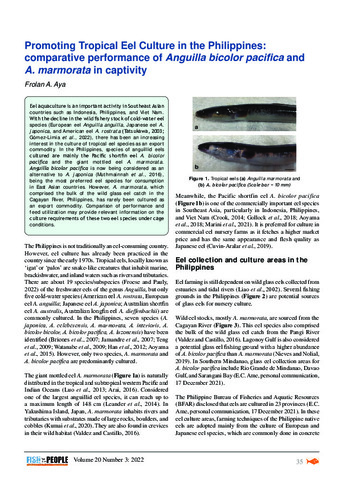Cage culture of tropical eels, Anguilla bicolor pacifica and A. marmorata juveniles: Comparison of growth, feed utilization, biochemical composition and blood chemistry
- Global styles
- MLA
- Vancouver
- Elsevier - Harvard
- APA
- Help

View/
Date
2022-11-02Page views
1,361ASFA keyword
AGROVOC keyword
Taxonomic term
Metadata
Show full item record
Share
Abstract
This study examined the performance and suitability of two tropical anguillid eels, Anguilla bicolor pacifica and A. marmorata, under cage culture conditions. Juvenile eels (1.73 ± 0.14 g body weight) of each species were stocked in triplicate hapa net cages (1 × 1 × 1.5 m; 30 eels/cage) suspended in outdoor tanks. Growth, feed utilization, biochemical composition and blood chemistry of the two species were compared after 210 days. Except for survival, mean final body weight (FBW), weight gain percentage (WG), specific growth rate (SGR) and yield of A. bicolor pacifica (64.51 ± 13.07 g, 3514 ± 690%, 2.14 ± 0.12%/day, 1534 ± 380 g/m3) were significantly higher than that of A. marmorata (7.77 ± 2.90 g, 356 ± 125%, 0.89 ± 0.16%/day, 178 ± 89 g/m3). In comparison with A. bicolor pacifica, significantly lower feed intake (FI), feed efficiency (FE) and protein efficiency ratio (PER) observed in A. marmorata suggest the need to develop eel diets with feeding stimulants to improve feed acceptance. Biometric indices, body proximate and amino acid composition were not significantly different between the two species. However, serum glutamic oxaloacetic transaminase (GOT), glutamic pyruvic transaminase (GPT) and total protein (TP) in A. bicolor pacifica were significantly higher than that in A. marmorata. These findings suggest that the differences in growth performance and feed utilization between the two anguillid eel species are related to feed palatability, and that A. bicolor pacifica appears to be a suitable species for cage culture because of its faster growth.
Subjects
EelsSuggested Citation
Aya, F., & Garcia, L. M. (2022). Cage culture of tropical eels, Anguilla bicolor pacifica and A. marmorata juveniles: Comparison of growth, feed utilization, biochemical composition and blood chemistry. Aquaculture Research , 53(17), 6283-6291. https://doi.org/10.1111/are.16101
Type
ArticleISSN
1355-557X; 1365-2109Collections
- Journal Articles [1258]
Related items
Showing items related by title, author, creator and subject.
-
Alternate day feeding as a cost-effective strategy for tank culture of the Pacific shortfin eel Anguilla bicolor pacifica
Aya, Frolan ; Unida, John Carlo L.; Romana-Eguia, Maria Rowena R.
; Unida, John Carlo L.; Romana-Eguia, Maria Rowena R.  ; Salayo, Nerissa D. (College of Agriculture and Food Science, University of the Philippines Los Baños, 2023-09)
There is a growing interest in the aquaculture of tropical anguillid eels as an export commodity. However, studies on feeding strategies, and the present demand to reduce feed costs need to be addressed to ensure the ...
; Salayo, Nerissa D. (College of Agriculture and Food Science, University of the Philippines Los Baños, 2023-09)
There is a growing interest in the aquaculture of tropical anguillid eels as an export commodity. However, studies on feeding strategies, and the present demand to reduce feed costs need to be addressed to ensure the ... -
Effect of stocking density on growth, biochemical composition and blood parameters in the Pacific shortfin eel Anguilla bicolor pacifica elvers
Aya, Frolan ; Unida, John Carlo L.; Garcia, Luis Maria
; Unida, John Carlo L.; Garcia, Luis Maria  ; Romana-Eguia, Maria Rowena R.
; Romana-Eguia, Maria Rowena R.  (College of Agriculture and Food Science, University of the Philippines Los Baños, 2024-09)
This study examined the effect of stocking density on growth, biochemical composition, and blood parameters of the Pacific shortfin eel Anguilla bicolor pacifica. Elvers (1.95 ± 0.14 g body weight) were randomly ...
(College of Agriculture and Food Science, University of the Philippines Los Baños, 2024-09)
This study examined the effect of stocking density on growth, biochemical composition, and blood parameters of the Pacific shortfin eel Anguilla bicolor pacifica. Elvers (1.95 ± 0.14 g body weight) were randomly ... -
Promoting tropical eel culture in the Philippines: Comparative performance of Anguilla bicolor pacifica and A. marmorata in captivity
Eel aquaculture is an important activity in Southeast Asian countries such as Indonesia, Philippines, and Viet Nam. With the decline in the wild fishery stock of cold-water eel species (European eel Anguilla anguilla, ...





